Bamako
 From Nwe
From Nwe | Bamako | |
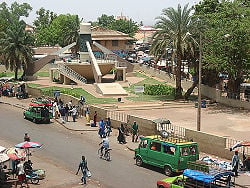
|
|
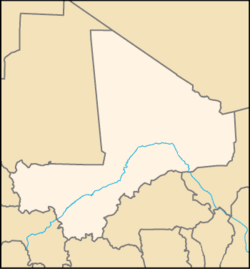
|
|
| Coordinates: 12°39′N 8°0′W | |
|---|---|
| Country | |
| Region | Bamako Capital District |
| Cercle | Bamako |
| Subdivisions | Communes |
| Government | |
| - Type | Capitol District |
| - Marie du District | Adama Sangaré[1] |
| Area | |
| - Capital City and Cercle | 245.0 km² (94.6 sq mi) |
| - Metro | 17,141.61 km² (6,618.4 sq mi) |
| Elevation [2] | 350 m (1,148 ft) |
| Population (1 April 2009)(Census, provisional) | |
| - Capital City and Cercle | 1,809,106 |
| - Density | 7,384.11/km² (19,124.8/sq mi) |
| - Metro | 2,757,234 |
| - Metro Density | 160.85/km² (416.6/sq mi) |
| Time zone | Coordinated Universal Time (UTC-0) |
Bamako, a city of nearly 1.7 million people, is the capital and largest city of Mali, which is among the poorest countries in the world. Estimated in 2006, to be the fastest growing city in Africa (and sixth fastest in the world), Bamako is the seventh largest West African urban center after Lagos, Abidjan, Kano, Ibadan, Dakar, and Accra.
Inhabited for more than 150,000 years, the area that is now Bamako has been part of the great west African empires, a French colony until independence in 1960, and it went through 24 years of single-party socialist rule.
Bamako is a city exhibiting the effects of extreme poverty and lack of government prioritization for social services, health, and education. While the city's people have suffered poverty's ravages, they have not resigned themselves to victimhood. Instead, the city has served as host to several important conventions that resulted in policies or initiatives set to improve life in various respects for citizens of African nations. Two of the most prominent resulted in what are known as the Bamako Initiative, which helped reshape health policy of Sub-Saharan Africa, and the Bamako Convention, dealing with the dumping of toxic waste into African nations from outside the continent. The city is the end-point of the largest annual charity event in Africa, known as the Budapest-Bamako Rally.
While Bamako is the center of the distinctive griot music, which has attracted high-profile Western performers to the nation, it is also an important center of culture and meeting place of Mali's great variety of ethnic groups.
Geography
The name Bamako comes from the Bambara word meaning "crocodile's back."
Bamako, is a hot, dusty city that spans both sides of the wide and murky Niger River, near rapids that divide the Upper and Middle Niger Valleys, in the southwestern part of Mali. Bamako, which feels like an overgrown village, with a handful of high-rises, is relatively flat, except to the north where there is an escarpment, remains of an extinct volcano. The majority of roads in the city are unpaved, getting dusty in the dry season and muddy during the rainy season. Goats graze along roadsides. Sheeps, chickens, and donkeys also roam alongside the roads.
Niger River tributaries defined the development of the city which is on a flood plain, so much of the land bordering the river cannot be used for construction. The Presidential Palace and the country's main hospital are located there.
Bamako is hot and dry from February to June, reaching 101°F in April; rainy, humid, and mild from June to November (between 71°F to 88°F); and cool and dry from November to February (between 63°F to 90°F). Precipitation reaches 14 inches (350 mm) in August.

The Niger River is navigable 225 miles (360 km) south, to Kouroussa, Guinea, during the wet season, while a canal around the Sotuba Rapids has enabled shipping to Gao 869 miles (1398 km) to the north.
Originally, the city developed on the northern side of the river, but as it grew, bridges were developed to connect the north with the south. There is an older submersible bridge between the eastern neighborhoods of Sotuba and Misabugu inherited from colonial times. It is typically under water from July to January.
The traditional commercial center of Bamako is to the north of the river, and contained within a triangle bounded by Avenue du Fleuve, Rue Baba Diarra, and Boulevard du Peuple. This area contains the Marché Rose and Street Market.
The downtown area is highly congested, polluted, and expensive, and urbanization is sprawling at a rapid pace within a radius of 19 miles (30 km). The largest urbanized area lies on the southern bank of the Niger River. A modern Central Business District is developing immediately west of the downtown area, following a geometric layout, the legacy of the old airport runways and taxiways. A large Administrative City is being developed near the King Fadh Bridge, purportedly to host most state departments' (ministries) and administrative services.
History

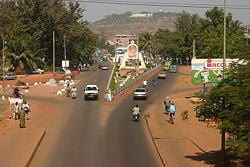
The fertile lands of the Bamako region have been inhabited for more than 150,000 years. Early kingdoms grew rich through trading gold, ivory, kola nuts, and salt using trade routes crossing the Sahara into northern Africa, and eventually to Europe.
By the eleventh century the Empire of Ghana (750-1076) became the first dominant kingdom in the area, and the city of Timbuktu became a commercial center with over 100,000 inhabitants, and a center for Islamic learning. Two universities were built as well as several mosques.
The Mali Empire (1235-1600), which included modern day Mali, Senegal, Gambia, Guinea, and Mauritania, became rich trading cotton and salt.
The Songhai Empire (1464-1591) had a professional army, a civil service and even subsidized doctors and religious leaders. In the 16th century Berber invaders from Morocco destroyed what remained of the kingdoms in Mali and trader-sailors began to undermine trans-Saharan trade.
Bamako was founded in the seventeenth century by Seribadian Niaré and Soumba Coulibaly, or Bamba Sanogo, before its chiefdom passed to Diaoussadian Niaré. The city was an important market town.
In 1883, the region was occupied by French troops, at which time it was a settlement of a few hundred inhabitants, grouped in villages. The cultivation of cotton and rice was encouraged through large irrigation projects.
In 1908, Bamako became the capital of the French Sudan, four years after the Kayes–Bamako segment of the Dakar–Niger Railway, which connected the Niger River with the port of Dakar, was opened. Its population grew to approximately 160,000 in 1960.
In early 1959, the union of Mali and Senegal became the Mali Federation, which gained independence from France on June 20, 1960. Senegal withdrew from the Mali Federation after a few months. The Republic of Mali, under Modibo Keïta, withdrew from the French Community on September 22, 1960.
Keïta was the victim of a coup in 1968, bringing to power young officers belonging to the Military Committee for National Liberation. When the committee broke up, a single party emerged and ruled until 1991.
Public opposition to the single-party regime led to a coup in 1991, a transitional government, and a new constitution. In 1992, Alpha Oumar Konaré won Mali's first democratic, multiparty presidential election. Upon his re-election in 1997, Konaré pushed through political and economic reforms and fought corruption. In 2002, he was succeeded in democratic elections by Amadou Toumani Touré, a retired general who had been a leader of the 1991 democratic uprising.
Government and politics
Mali is a republic in which a president, who is elected for a five-year term, appoints the prime minister and chairs the Council of Ministers, which adopts proposals for laws submitted to the National Assembly for approval. The National Assembly is the sole legislative arm and consists of 147 members. Mali is divided into eight administrative regions, which are made up of districts. These districts are composed of communes, which contain villages. Since decentralization plans began, a total of 702 local municipal councils have been formed. These are headed by elected mayors.
Mali is a source, transit, and destination country for women and children trafficked for the purposes of forced labor and sexual exploitation. Women and girls are trafficked for domestic servitude and sexual exploitation, and boys for work in rice fields or gold mines and for begging. Although the majority are sold within the country, the victims are also sent to neighboring nations (Libya) and Europe.
Economy
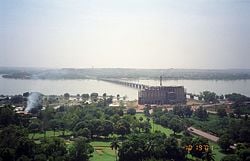
Mali is among the poorest countries in the world, with 65 percent of its land area desert or semi-desert and with a highly unequal distribution of income. About 10 percent of the population is nomadic and some 80 percent of the labor force is engaged in farming and fishing. Industrial activity is concentrated on processing farm commodities. Mali is heavily dependent on foreign aid and vulnerable to fluctuations in world prices for cotton, its main export, along with gold.
Bamako is the nation's administrative center, with a river port located in nearby Koulikoro, and a major regional trade and conference center. Manufactures at Bamako include textiles, processed meat and metal goods. There is commercial fishing on the Niger River.
Per capita GDP was US$1000 in 2007, with a rank of 163 on the international Monetary Fund list of 179 nations.
River transport is used extensively. Cement and petroleum products are shipped down the river from the city. Rice and peanuts are moved upstream to be freighted on the Dakar-Niger Railway, to Koulikoro in eastern Mali, and Dakar in Senegal. Bamako Senou International Airport, Mali's main airport, is located some 15 km south of downtown Bamako. Passenger traffic reached the 516,000 mark in 2005.
Demographics

Bamako's population was 1,690,471 in 2006. Rural migration from drought-stricken areas tripled the size of the city from 1960 to 1970. Bamako was listed, in 2006, as the sixth fastest growing urban area on a list of 100 cities, growing at a rate of 4.45 percent each year.
The ethic groups of Mali comprise Mande 50 percent, (Bambara, Malinke, Soninke), Peul 17 percent, Voltaic 12 percent, Songhai six percent, Tuareg and Moor 10 percent, and others five percent.
While French is the official language, 80 percent speak Bambara, which belongs to a group of closely-related languages called Manding, while numerous other African languages are spoken.
Ninety percent of the population are Muslim, Christians make up one percent, while the remaining nine percent follow indigenous beliefs.
Bamako is the location of several research institutes and four colleges.
Society and culture

Bamako is the center of the distinctive griot music. The soulful singer Salif Keita and the late singer-guitarist Ali Farka Touré sparked a boom in Malian music in the 1990s. The country's griot music, with haunting melodies based on the pentatonic scale, and its themes of shattered romance, has similarities with American blues music. Western artists including Robert Plant, Ry Cooder, Bonnie Raitt, and the late John Lee Hooker have visited Bamako to jam and record with the local musicians.[3]
Bamako is known as Mali's center of culture. Singers and instrumentalists from the nation's various tribes—the Sorhai of Timbuktu, the Dogon cliff dwellers, the Peuls of central Mali, the Tuaregs of the Sahara, the Malinkes from the border region south of Bamako, and the Wassalous near the Ivory Coast—come together in Bamako.[3]
Notable landmarks in Bamako include the National Library of Mali, Tour BCEAO, Bamako Grand Mosque, Cathedral of Bamako, and the King Fahd Bridge.
Attractions include the Mali National Museum, the Muso Kunda Museum, the Bamako Regional Museum, Bamako Zoo, the Bamako Botanical Gardens, and the Point G hill, containing caves with rock paintings. Bamako has hosted the biannual photography festival African Photography Encounters since 1994.
Motion picture
A film entitled Bamako was released at the Cannes Film Festival on May 21, 2006. It was released in the United States on February 14, 2007, in Manhattan, by New Yorker Films. Directed by Abderrahmane Sissako, the film, which was set in Bamako, was both a courtroom drama and a portrait of everyday Mali life. The film posed the question of whether the World Bank and IMF, or perhaps corruption, are guilty of the current financial state of many poverty-stricken African countries. While the film addressed two sides of an issue, it also offered a realistic portrayal of life in Bamako and many other cities in developing nations.
International role
Bamako has served as host city to several important conventions that resulted in policies or initiatives set to improve life in various respects for citizens of African nations. Two of the most prominent resulted in what are known as the Bamako Initiative and the Bamako Convention. It also hosts the largest annual charity event in Africa, known as the Budapest-Bamako Rally.
Bamako Initiative

In the late 1980s, Sub-Saharan Africa was in a deep political and economic crisis. Debt service obligations were collapsing stagnant economies. In several countries the child mortality rates exceeded 200 per 1,000 live births. Financial crises resulted in nearly non-existent budgets for health, education, and other social services, despite the increase in population.
During the September 1987 World Health Organization Regional Meeting of the African Ministers of Health, James Grant, a representative of UNICEF, offered proposals vastly different from what was in place in regards to health care on the continent. Though not all of what he offered was accepted, an initiative was drawn up, the Bamako Initiative; a pragmatic strategy that helped reshape health policy of Sub-Saharan Africa.[4]
Bamako Convention
The Bamako Convention (in full: Bamako Convention on the ban on the Import into Africa and the Control of Transboundary Movement and Management of Hazardous Wastes within Africa) is a treaty of African nations prohibiting the import of any hazardous (including radioactive) waste. The Convention was negotiated by twelve nations of the Organization of African Unity in the city of Bamako, in January 1991. It came into force later that decade and by the end of 2007 had been ratified by 23 member nations.[5] Only states which are members of the Organization of African Unity (OAU) can become a party to the Bamako Convention.
The objectives of the Convention are designed to protect both the environment and human health from dangers posed by hazardous wastes by reducing their generation to a minimum. All participating nations are required to prohibit the import of all hazardous wastes, for any reason, into Africa from other continents.[6]
The impetus for the formation of the Bamako Convention arose from the failure of the Basel Convention to prohibit trade of hazardous waste to less developed countries, and from the discovery that developed nations were exporting toxic wastes to Africa. Of several prominent cases, one which occurred in 1987, concerned the importation into Nigeria of 18,000 barrels of hazardous waste from the Italian companies Ecomar and Jelly Wax, which had agreed to pay a local farmer (Sunday Nana) a monthly fee for storage. The barrels, found in storage in the port of Lagos, contained toxic waste including polychlorinated biphenyls, and their eventual shipment back to Italy led to protests closing three Italian ports.
The Bamako Convention uses a format and language similar to that of the Basel Convention, but is much stronger in prohibiting all imports of hazardous waste. Additionally, it does not make exceptions on certain hazardous wastes (such as those for radioactive materials) made by the Basel Convention.
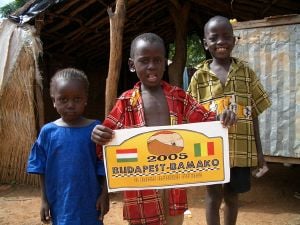
Budapest-Bamako Rally
The Budapest-Bamako, or Great African Run, is the world's largest trans-Saharan rally and the largest charity car race in Africa. It passes through the nations of Hungary, Austria, Italy, France, Spain, Morocco, Mauritania, and Mali.
The rally has grown into a major international sporting and cultural event, with hundreds of teams setting out each winter, not only for adventure, but also to bring direct aid to Africa's poorest communities. Each year the charities have a different focus. In 2008, nearly 500,000 Euros worth of aid was delivered. A fresh-water well in a Mauritanian village was dug. An incubator, sterilization equipment and other medical supplies were donated to a free clinic that had been operating with prehistoric tools in a Bamako slum. Schools received funding. After the race several teams donated their vehicles to villages to be used as ambulances and school buses. Each year the team performing the most outstanding charity work receives the Mother Teresa Charity Award.[7]
Notes
- ↑ Coupe du Maire du District : Le Stade reçoit son trophée. L'Essor, 24 September 2008
- ↑ Population of Bamako, Mali, Latitude, Longitude, and Elevation Mongabay.com. Retrieved March 14, 2012.
- ↑ 3.0 3.1 Joshua Hammer, Siren song of Mali, The New York Times. Retrieved July 23, 2008.
- ↑ Agostino Paganini, The Bamako Initiative Was Not About Money, International Federation of Catholic Universities.
- ↑ Union Africaine, List of Countries which have Signed, Ratified/Acceded Bamako Convention. Retrieved July 25, 2008.
- ↑ Organization of African Unity, Bamako Convention. Retrieved July 25, 2008.
- ↑ Budapest-Bamaka Great African Run, Great African Run. Retrieved July 25, 2008.
References
ISBN links support NWE through referral fees
- City Mayors Statistics. World's fastest growing cities and urban areas from 2006 to 2020. Retrieved June 26, 2019.
- Dulucq, Sophie. Bamako. Encyclopedia of African History, 122-123. 2005. OCLC 61749600
- Perinbam, B. Marie. Identity ritual and the state in the Bamako Kafu and Mande-hinterland. [S.l.]: African Studies Association, 1994. OCLC 122267480
- UNICEF. The Bamako Initiative.
|
|||||||||||||
Credits
New World Encyclopedia writers and editors rewrote and completed the Wikipedia article in accordance with New World Encyclopedia standards. This article abides by terms of the Creative Commons CC-by-sa 3.0 License (CC-by-sa), which may be used and disseminated with proper attribution. Credit is due under the terms of this license that can reference both the New World Encyclopedia contributors and the selfless volunteer contributors of the Wikimedia Foundation. To cite this article click here for a list of acceptable citing formats.The history of earlier contributions by wikipedians is accessible to researchers here:
- Bamako history
- Bamako_Convention history
- Bamako_(film) history
- Budapest-Bamako history
The history of this article since it was imported to New World Encyclopedia:
- History of "Bamako"
Note: Some restrictions may apply to use of individual images which are separately licensed.
↧ Download as ZWI file | Last modified: 02/03/2023 23:01:54 | 11 views
☰ Source: https://www.newworldencyclopedia.org/entry/Bamako | License: CC BY-SA 3.0
 ZWI signed:
ZWI signed: KSF
KSF